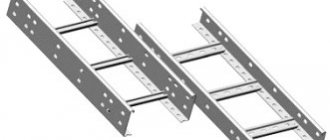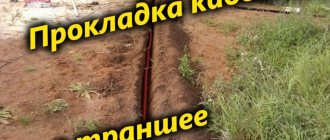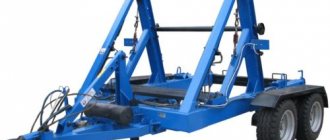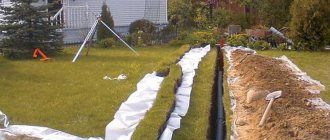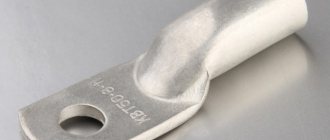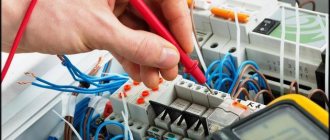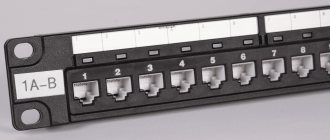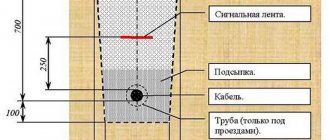As a rule, consumers are connected to power sources (transformer and distribution substations) using cable lines (CL). This is due to the fact that this method has many advantages over overhead lines (OL). But, if there is an accident on the cable line, then finding the location of the cable damage without special instruments is almost impossible. Today we will look at several ways to localize an emergency section of a cable route laid in the ground.
Causes and types of damage to cable lines
There are many factors that negatively affect the integrity of power cables, the most common of which include the following:
- Ground movement can be caused by a failure of water supply, sewer or heating networks, as well as seasonal phenomena, for example, spring thawing.
- Exceeding the permissible operating standards for cable lines, which can lead to thermal overload of the line caused by an increase in current load.
- Formation of a high level of electric current in the cable line from a transit short circuit.
- Mechanical damage during excavation work without taking into account the passage of underground communications and the depth of the route.
- Errors when laying cable lines. As an example, we can cite violations of the technology for connecting cores with cable couplings.
- Manufacturing defects.
Note that when cable routes are laid open, some of the above causes of damage are extremely rare. In particular, the likelihood of the influence of soil movement and mechanical impacts due to excavation work is reduced. In addition, damage zones of open cable lines, in most cases, can be detected by visual inspection, without the use of special methods.
Having dealt with the reasons, let’s move on to the types of damage, since this directly determines the method by which the emergency section of the cable line will be localized.
Most often, repair teams have to deal with the following types of faults:
- A defect caused by a complete or partial break of a cable line. Most often, the cause of the accident is excavation work without determining the passage of cable routes. Somewhat less frequently, the cause of this damage can be a short circuit in the couplings.
- In power cables (more than 1 kV), breakdown of one of the conductors to ground (single-phase short circuit) is often encountered. Leakage current, as a rule, is caused by a decrease in the quality of insulation during operation of the cable line.
- Interphase damage, as well as types of metal short circuits, can occur in any lines; the cause of damage is the same as in the previous paragraph.
- Routine cable testing, which involves high voltage levels, shows low insulation reliability and leads to breakdown. Under certain circumstances, such a line can continue to operate, but due to its low level of reliability, an accident can occur at any time.
How to find the location of cable damage?
During operation and at the stage of installation of cable lines laid underground, unexpected mechanical damage to the insulation and current-carrying conductors occurs. This may be due to a violation of normal operating conditions, careless installation work on other communications located a few meters from the installation site and not related to the power supply line. We will further describe how to search for cable damage underground and in the wall, providing existing methods and instruments for detecting the faulty area.
To find the location of the cable line damage, you need to understand the specifics and methodology of the search. The process must be divided into two stages:
- Search for problem areas along the entire length of the line.
- Searching for an accident site on a designated section of the highway.
There are several methods for finding the damaged area:
- Pulse method;
- Loop method;
- Acoustic method;
- Induction method;
- Step voltage method.
Pulse method.
This method involves searching for damage using a reflectometer. The operation of the device is based on sending probing pulses of a certain frequency, which, when encountering an obstacle in their path, are reflected and returned back to the device. That is, the device is located at one end of the power cable, which is very convenient and practical. Tests should be carried out on a completely disconnected line.
Loop method.
This method is applicable provided that at least one wire in the cable remains intact, or another conductor with intact cores lies nearby. To find out the distance to the place of damage using the loop method, you need to measure the DC resistance of the wires with the P333 device. This is a DC measuring bridge. This is one of the first methods invented to find the location of the fault, and it is used exclusively for single-phase and two-phase faults. Gradually they stop using it, due to its labor intensity and large error in measurements.
Acoustic method.
You can find a break in a cable using the acoustic method by creating a discharge at the damage site using a high-voltage pulse generator. At the location of the break or short circuit, sound vibrations of a certain frequency will appear. The quality of listening depends on the type of soil, the distance from the surface to the cable line and the type of damage. A prerequisite for the method to work is to exceed the contact resistance value of 40 ohms.
Step voltage method.
The method is based on passing current generated by a generator through a cable. It creates a potential difference between two points located in the ground, which can be judged by the current leakage at the site of the accident. To find a point with reduced insulation resistance, contact probe probes are installed like this - the first one is exactly above the running conductor, the second one is at an angle of 90, a meter from the first one.
Induction method.
The method very accurately determines the location of the break, but its use is associated with burning the cable. If the transition resistance is high, it is necessary to reduce its value by burning using special devices. The method is based on passing a high-frequency current through the core, which forms an electromagnetic field above the cable line. In places of mechanical damage to the route, passing the receiving frame, the sound will change. Thus, the absence of sound indicates a wire break.
A special device - a locator - will help you find the location of a wire break in a concrete wall.
It is a combination of a receiver and an oscillator. This method can be associated with the induction method in searching for cable faults underground. Share post
Briefly about cable line repair
Repair work on cable lines is usually classified into planned and emergency. As for the volume of such work, for the former it is, as a rule, capital, for the latter it is current.
During major works, planned replacement of cable lines, laying of new routes, etc. are carried out. If necessary, repairs and/or upgrades of related equipment are also performed. The latter include ventilation systems and lighting for cable tunnels, as well as pumps for pumping out groundwater. Considering the specifics of planned work, localization of defective areas is not required during their implementation.
The situation is completely different during emergency repairs. In order not to dig up the entire route, you should accurately determine the location of the wire break, insulation breakdown, etc. For this purpose, various methods are used, for which special equipment is used. This will be discussed in detail below.
Determining the exact location of the break
After a break has been found with a multimeter, you should determine exactly where it happened. To make your task easier, you should remember that the wiring can be located inside the system, strictly horizontally or vertically. Under the wallpaper, you can visually determine the location of the grooves by small swellings. If these swellings go to the location of the switch or sockets, electrical wiring is hidden under them.
How to determine the location of the fault if the visual detection method is not suitable? You can use such an inexpensive device as a cable tracker. These devices are also called testers/trackers, dialers. The kit includes two devices - a signal generator (emitter) and a receiver (receiver). The generator is connected to the wire being tested using crocodiles. The receiver will indicate with great accuracy where the wiring is located. It can also be used to check the integrity of computer and telephone network wires.
After discovering the cable laying, it should be released from the groove and the faulty piece going to the junction box should be replaced. It may be that there is no voltage inside the box itself. Then you need to look for and check the wire that is laid from the electrical panel to the distribution box. The sequence of actions is the same.
How does the search for a broken cable go underground?
We divide the work into two components:
- Determine the general area within which there is damage;
- Identify the exact location of the problem within it.
Accordingly, first, to find the location of a fault in a 10 kV cable, we select relative detection methods, and at the second stage, the most detailed ones.
We have the best price/quality ratio. Pay attention to the professional methods that we use; our prices for such equipment are very favorable.
| Search | from 12,500 rub. |
| Opening | from 3,000 rub. |
| Repair | from 3,000 rub. |
| Travel outside the Moscow Ring Road | 30 rub/km |
Important: each case is calculated individually. Call for details.
Examples of finding a cable break in the ground
- in stock
- In the countryside
They were called to an industrial facility - a grocery store warehouse. An acoustic method was used to detect defects. Found.
We carried out work on a suburban site in the Moscow Region. The induction method was used. We found a gust in the highway and recorded it.
How to find a cable break in the ground
We use a highly specialized set of equipment that allows us to select the correct method for searching for cable line damage in different situations.
- Induction method
- Acoustic
- Induction-acoustic
- Potential
We generate electromagnetic waves around the network (a generator is needed for this), and in parallel we explore the earth with a magnetic locator. The device shows the strength of the electrical signal, and we use it as a starting point when searching for a cable break underground.
Reveals: place and depth.
We apply high voltage pulses to the damaged wire. At the scene of the accident, spark discharges occur, which can be heard using a specialized sensor. A good way to find cable damage in the ground.
Or acoustic-electromagnetic. When the sound signal is not enough, our equipment allows us to receive both sound and electromagnetic signals simultaneously, which allows us to quickly narrow the search area for damage to a 10 kV cable.
Due to cable failure, currents and potential differences arise in the soil. Our generator produces alternating voltage, and by calculating the specifics of its changes along the route, we search for a cable break in the ground.
Induction method
One of the universal methods that allows you to accurately determine a break or other malfunction in the wire itself or at the point of cable connection with a coupling. In addition to the exact location of the accident, the depth of the accident is also determined. This facilitates and speeds up access to the injury site.
Passing through the veins, alternating current forms an electromagnetic field. As long as current flows through a working cable, this field is uniform. As soon as it hits an obstacle, the field indicators change. This method is based on detecting such changes.
A high-frequency current is passed through the cable, which can create an electromagnetic field strong enough to be examined. Experts call this impact burning the cable line. The cable damage indicator is a receiving frame that generates an alternating current frequency of 850 to 1250 Hz in the form of an audible signal. The location of the accident is determined by a change in the tone of the sound or by its disappearance. This is a reliable method, proven in practice.
How does the search for a broken cable go underground?
When searching for a cable breakdown underground, MSK search encounters:
- line break due to construction work;
- short circuit in connecting couplings;
- only 1 wire strand breaks into the ground;
- metal short circuits that occurred due to the destruction of communication insulation;
- breakdowns that appeared during testing.
Our craftsmen are certified by Rostechnadzor and passed through MOEK. Experience gives quality. Quality gives reliability, regular customers and confidence that we are one of the best in this field. We will be glad to cooperate.
- We work with legal entities and individuals.;
- 8 years of experience;
- More than 1000 objects.
Source: msk-poisk.ru


